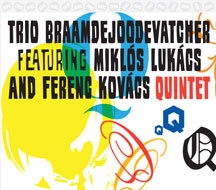Product Details
- An MVD Exclusive
- SKU: BMCCD179
- Format: CD
- UPC: 5998309301797
- Street Date: 09/07/10
- PreBook Date: 08/03/10
- Label: BMC Records »
- Genre: Jazz
- Run Time: 57 mins
- Number of Discs: 1
- Year of Production: 2010
- Box Lot: 25
- Territory: NA,GB,AU
Product Assets
Trio Braamdejoodevatcher & Lukacs, Miklos / Kovacs, Ferenc - Quintet

- List Price: $15.99
- Your Price: $15.99
- In Stock: 26
You must login to place orders.
We've played the Q program all over the world, with various guests. Normally we fly in, rehearse for an hour or two, and play the concert. One of the nice things about improvised music is that this works! You simply get together with a complete stranger and immediately start communicating musically with him or her. It's genuine communication where you lay yourself bare.
Track Listing
|
|
Press Quotes
How can a trio be a quintet? That mathematical impossibility can be expressed along with other anomalies when dealing with creative improvised music. A long-established trio in the Netherlands, made up of pianist Michiel Braam, bassist Wilbert de Joode and American drummer Michael Vatcher, Trio BraamdeJoodeVatcher has over evolved time a program based on Braam's Q compositions that are adaptable to many situations. Just how adaptable is demonstrated on this fine CD with the trio performance expanded to include two of Hungary's most-accomplished improvisers - trumpeter/violinist Ferenc Kovács, and Miklós Lukács, who plays the traditional cimbalom, or oversized, horizontal hammered zither. Both Budapest-based players are regular associates in the bands of tenor saxophonist Mihály Dresch, the country's most consistently adventurous Jazzer. Lukács has also played with the French-Hungarian combo Ozone and Kovács with American drummer Hamid Drake. Putting the stodgy traditionalism of their favored instruments aside, Kovács' and Lukács' versatility allows them to find common ground with the Dutch-American trio. Kovács, whose tough, modal trumpet playing is also featured throughout, shows off his neo-Roma fiddling to its best advantage on 'Q1' and 'Q16', while the unique tones of Lukács' so-called string-piano are aptly demonstrated on 'Q10' and 'Q 26'. 'Q1' for example is as close to hard R&B as a string-constituted combo such as this can get. With metronomic low frequency chords played by Braam and doubled by de Joode's thumping bass notes, this piece could be a Magyar-Dutch interpretation of Blues singer John Lee Hooker's 'I'm Mad Again.' A chordal ostinato continues throughout it and is joined by Vatcher's bass drum thumps, even as Kovács produces a counter line of spiccato and sul ponticello Roma-like fiddle strokes. 'Q16' encompasses even more gypsy-styled fiddling, although here the stuttering double-stopped strings alternate with spangling, twangy resonations from Lukács' instrument and popped brush strokes from the drummer. On the other hand, 'Q10' is defined by andante pacing from the keyboardist plus a thick walking bass line. Taking up the additional space are Kovács' trumpet's rubato grace notes and Lukács' string fills. A rare cheery swinger that stands out among the melancholic tunes which surround it, 'Q10' is equally satisfying. More typical is 'Q26', which is built around pressurized friction. With the bassist's col legno pumping, the cimbalomist's strums and plucks and Braam's defining key clanks, the backdrop augments and flattens to properly display the trumpeter's well-constructed solo. Initially the valve expansion works its way downwards to near silence and then upwards to a brassy finale. Other pieces voice the multiple string sets in ways that the resulting polyphony references both contrapuntal chamber music plus the intoxicating sonic freedom of concentrated, cerebral improvisation. This quintet may be ad-hoc, but admirable as well. Although the Dutch-American trio members only met the Hungarian stylists the day before Quintet was recorded, from the evidence here any number of encores could and should be considered.
—Ken Waxman, Jazz Word
